
Veracruz, formally Veracruz de Ignacio de la Llave, officially the Estado Libre y Soberano de Veracruz de Ignacio de la Llave, is one of the 31 states which, along with Mexico City, comprise the 32 Federal Entities of Mexico. Located in eastern Mexico, Veracruz is bordered by seven states, which are Tamaulipas, San Luis Potosí, Hidalgo, Puebla, Oaxaca, Chiapas, and Tabasco. Veracruz is divided into 212 municipalities, and its capital city is Xalapa-Enríquez.

The Pastry War, also known as the first French intervention in Mexico or the first Franco-Mexican war (1838–1839), began in November 1838 with the naval blockade of some Mexican ports and the capture of the fortress of San Juan de Ulúa in the port of Veracruz by French forces sent by King Louis Philippe I. It ended in March 1839 with a British-brokered peace. The intervention followed many claims by French nationals of losses due to unrest in Mexico. This would be the first of two French invasions of Mexico; a second, larger intervention would take place in the 1860s.

Xalapa or Jalapa, officially Xalapa-Enríquez, is the capital city of the Mexican state of Veracruz and the name of the surrounding municipality. In the 2020 census the city reported a population of 443,063 and the municipality of which it serves as municipal seat reported a population of 488,531. The municipality has an area of 118.45 km2. Xalapa lies near the geographic center of the state and is the second-largest city in the state after the city of Veracruz to the southeast.

Boca del Río is a city and municipality located in the center of the Mexican state of Veracruz. The small city of Boca del Río serves as the seat of the municipality. The municipality lies just south of the municipality of Veracruz, and contains a part of the city and city and port of Veracruz. It is a port in its own right, as well as the metropolitan area's center for business travel and upscale hotels and restaurants. The city contains two museums, one dedicated to Agustín Lara and the other a military ship that has been converted into a museum. However, the municipality's main feature is the World Trade Center Veracruz, which hosts business meetings, conferences and conventions.
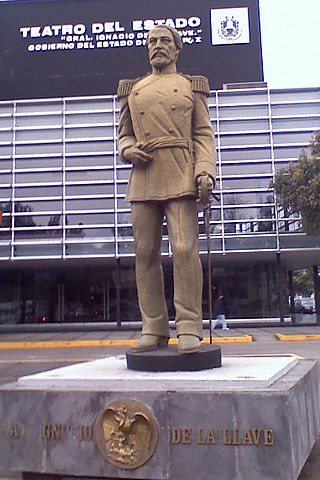
Ignacio de la Llave y Segura Zevallos was a general and the governor of the Mexican state of Veracruz (1861–1862).

Tres Valles is a town and municipality in the Mexican state of Veracruz, created as a free municipality by decree on November 25, 1988. It is located in the lower reaches of the Papaloapan, and borders the state of Oaxaca and the towns of Tierra Blanca and Cosamaloapan.
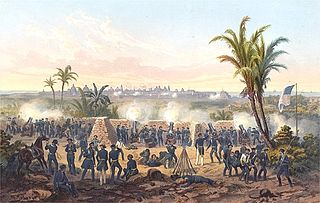
On 9 March 1847, during the Mexican–American War, the United States military made an amphibious landing and besieged the key Mexican seaport of Veracruz. The port surrendered twenty days later. The U.S. forces then marched inland to Mexico City.

Veracruz, also known as Heroica Veracruz, is a major port city and municipal seat for the surrounding municipality of Veracruz on the Gulf of Mexico and the most populous city in the Mexican state of Veracruz. The city is located along the coast in the central part of the state, 90 km (56 mi) southeast of the state capital Xalapa.

David Conner was an officer and commodore of the United States Navy. He served in the War of 1812 and led the Home Squadron during the Mexican–American War. He led the successful naval assault during the siege of Veracruz which included the landing of 10,000 U.S. troops, the largest U.S. military amphibious assault at the time. He served on the Board of Navy Commissioners; as the first Chief of the Bureau of Construction, Equipment, and Repair; as a Special Diplomatic Agent to Mexico and commanded the Philadelphia Naval Yard.

The Battle of Veracruz began with the occupation of the port city of Veracruz by the United States and lasted for seven months. The incident came in the midst of poor diplomatic relations between the United States and Mexico, and was related to the ongoing Mexican Revolution.
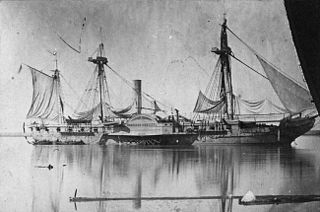
The Home Squadron was part of the United States Navy in the mid-19th century. Organized as early as 1838, ships were assigned to protect coastal commerce, aid ships in distress, suppress piracy and the Atlantic slave trade, make coastal surveys, and train ships to relieve others on distant stations. It was discontinued in 1861 after the outbreak of the American Civil War, when the Union blockade forced a reassignment of ships to close off Southern ports.
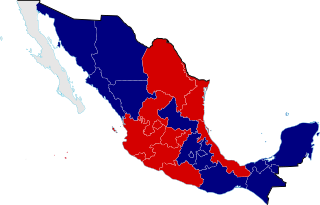
The Reform War, or War of Reform, also known as the Three Years' War, and the Mexican Civil War, was a complex civil conflict in Mexico fought between Mexican liberals and conservatives with regional variations over the promulgation of Constitution of 1857. It has been called the "worst civil war to hit Mexico between the War of Independence of 1810-21 and the Revolution of 1910-20." Following the liberals' overthrow of the dictatorship of conservative Antonio López de Santa Anna, liberals passed a series of laws codifying their political program. These laws were incorporated into the new constitution. It aimed to limit the political power of the executive branch, as well as the political, economic, and cultural power of the Catholic Church. Specific measures were the expropriation of Church property; separation of church and state; reduction of the power of the Mexican Army by elimination of their special privileges; strengthening the secular state through public education; and measures to develop the nation economically.
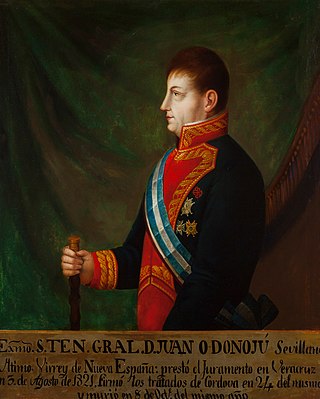
Juan José Rafael Teodomiro de O'Donojú y O'Ryan was a Spanish-Irish military officer, diplomat and Viceroy of New Spain (Mexico) from 21 July 1821 to 28 September 1821 during the Mexican War of Independence. He was the last Viceroy of New Spain.

The United States involvement in the Mexican Revolution was varied and seemingly contradictory, first supporting and then repudiating Mexican regimes during the period 1910–1920. For both economic and political reasons, the U.S. government generally supported those who occupied the seats of power, but could withhold official recognition. The U.S. supported the regime of Porfirio Díaz after initially withholding recognition since he came to power by coup. In 1909, Díaz and U.S. President Taft met in Ciudad Juárez, across the border from El Paso, Texas. Prior to Woodrow Wilson's inauguration on March 4, 1913, the U.S. Government focused on just warning the Mexican military that decisive action from the U.S. military would take place if lives and property of U.S. nationals living in the country were endangered. President William Howard Taft sent more troops to the US-Mexico border but did not allow them to intervene directly in the conflict, a move which Congress opposed. Twice during the Revolution, the U.S. sent troops into Mexico, to occupy Veracruz in 1914 and to northern Mexico in 1916 in a failed attempt to capture Pancho Villa. U.S. foreign policy toward Latin America was to assume the region was the sphere of influence of the U.S., articulated in the Monroe Doctrine. However the U.S. role in the Mexican Revolution has been exaggerated. It did not directly intervene in the Mexican Revolution in a sustained manner.

Francis Moore Dimond was an American politician and the 23rd Governor of Rhode Island.

Antonio de Padua María Severino López de Santa Anna y Pérez de Lebrón, usually known as Antonio López de Santa Anna, or just Santa Anna, was a Mexican soldier, politician, and caudillo who served as the 8th president of Mexico multiple times between 1833 and 1855. He also served as Vice President of Mexico from 1837 to 1839. He was a controversial and pivotal figure in Mexican politics during the 19th century, to the point that he has been called an "uncrowned monarch", and historians often refer to the three decades after Mexican independence as the "Age of Santa Anna".

Oscar Melchor Peredo y Garcia is a Mexican muralist and a representative of the social realist school of mural painting in Mexico. His murals depict historical scenes from Mexican history with an emphasis on revolutionary subjects. His work is featured in public and government buildings across Mexico. He has also painted murals in the USA and Europe.

The Jalisco New Generation Cartel or CJNG, is a Mexican criminal syndicate, based in Jalisco and headed by Nemesio Oseguera Cervantes. The cartel has been characterized by extreme violence and public relations campaigns. Though the CJNG is known for diversifying into various criminal rackets, drug trafficking remains its most profitable activity. The cartel has been noted for cannibalizing some victims during the training of new sicarios or members, as well as using drones and rocket-propelled grenades to attack enemies.
The 2012 Veracruz murder of journalists is about the disappearance, murder and dismemberment of three journalists and a woman who worked in public relations whose bodies were discovered in Boca del Río, Veracruz, Mexico. Their bodies were recovered from a canal on World Press Freedom Day, or 3 May 2012, and showed signs of torture and mutilation, which prompted calls for investigations into links with organized crime. The gruesome murder followed other murders of members of the press in the Veracruz area and during the Mexican drug war, and highlighted the danger for working journalists.
Joaquín Urquiaga was a football player and manager who played professionally in Mexico and Spain.

















